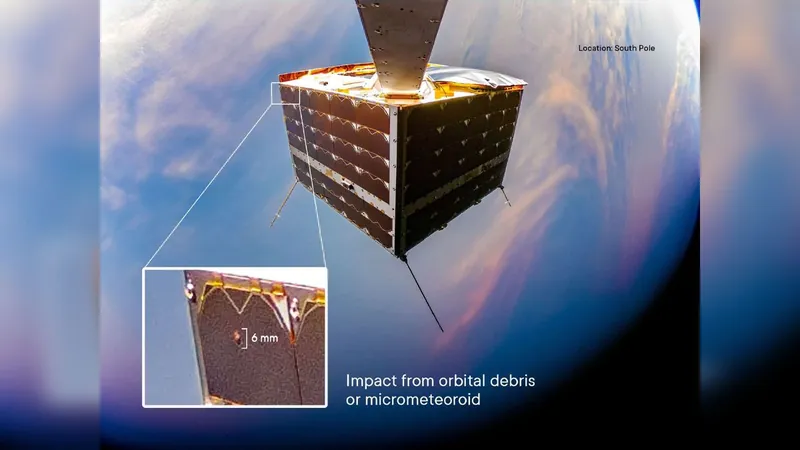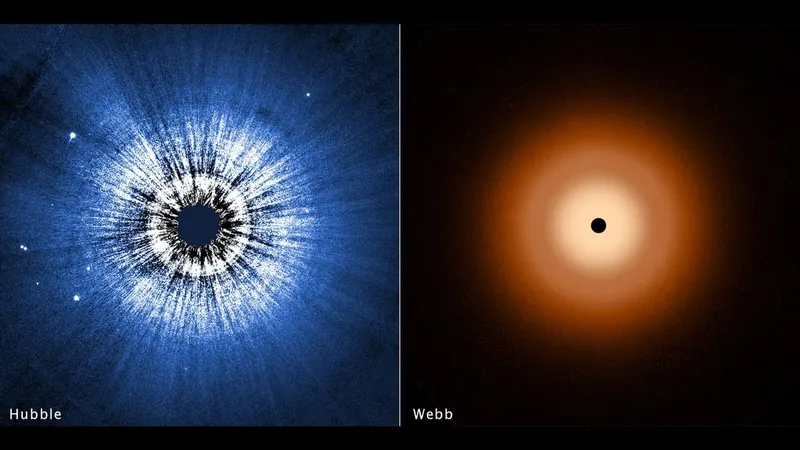
Satellite's Daring Encounter: Survives Space Impact and Captures Stunning Selfie!
2024-11-05
Author: Arjun
Introduction
A fascinating incident has emerged from the cosmos as a small satellite, the MP42, built by Lithuania's NanoAvionics, recently demonstrated the incredible resilience of modern space technology. A tiny 0.24-inch-wide (6-millimeter) hole in its solar panel was discovered after an on-board camera captured the shocking footage on October 24, 2023. The satellite has been a steadfast companion in Earth’s orbit since its launch in April 2022.
Unanswered Questions
In a statement released on X, NanoAvionics revealed they still have not determined if the puncture was caused by a micrometeoroid or a piece of space debris. The mystery deepens, as the camera hadn't recorded any images of the affected area in nearly 18 months prior to this discovery. Interestingly, despite the damage, the tiny hole has not hindered the satellite's ability to produce electricity—underscoring the durability of NanoAvionics' design.
The Challenge of Space Debris
This incident starkly illustrates the escalating issue of space debris, a growing menace in Earth's orbit. The European Space Agency (ESA) estimates there are about 130 million objects in space, ranging from minuscule to larger fragments, posing a risk to operational satellites and structures like the International Space Station. The close call serves as a sober reminder of the urgent need for responsible practices in space exploration and satellite operation.
Historical Context
It’s worth noting that this isn’t the first run-in with space debris. In 2016, a fragment punctured a solar panel on the ESA’s Sentinel 1A, although the mission ultimately regained its functionality. Just this past August, a set of larger debris pieces splintered off the payload adapter left by the Vega rocket, highlighting the ever-present dangers of space junk.
Predictions for the Future
Scientists predict that the situation could become catastrophic if two large defunct objects were to collide, generating thousands of new bits of debris—each a potential threat to functioning satellites. With over 1.1 million fragments of varying sizes already zooming around the planet, the current trajectory of space debris accumulation presents a significant challenge for future missions.
Corporate Responsiveness
Despite the inherent risks, NanoAvionics has successfully launched nearly 50 satellites over the past decade, performing only a limited number of collision avoidance maneuvers. Most recently, they executed a series of propulsive maneuvers in 2024 that drastically reduced the probability of collision with other space objects.
Conclusion
The implications of this satellite's encounter underscore a critical dialogue around space sustainability, emphasizing that action must be taken to better manage the increasing amounts of debris orbiting our planet. As the excitement around space exploration expands, so does the responsibility to maintain the celestial environment—and safeguard future missions!





 Brasil (PT)
Brasil (PT)
 Canada (EN)
Canada (EN)
 Chile (ES)
Chile (ES)
 España (ES)
España (ES)
 France (FR)
France (FR)
 Hong Kong (EN)
Hong Kong (EN)
 Italia (IT)
Italia (IT)
 日本 (JA)
日本 (JA)
 Magyarország (HU)
Magyarország (HU)
 Norge (NO)
Norge (NO)
 Polska (PL)
Polska (PL)
 Schweiz (DE)
Schweiz (DE)
 Singapore (EN)
Singapore (EN)
 Sverige (SV)
Sverige (SV)
 Suomi (FI)
Suomi (FI)
 Türkiye (TR)
Türkiye (TR)